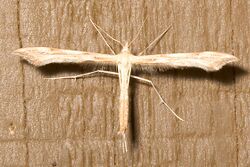Biology:Gillmeria pallidactyla
| Gillmeria pallidactyla | |
|---|---|

| |
| Scientific classification | |
| Domain: | Eukaryota |
| Kingdom: | Animalia |
| Phylum: | Arthropoda |
| Class: | Insecta |
| Order: | Lepidoptera |
| Family: | Pterophoridae |
| Genus: | Gillmeria |
| Species: | G. pallidactyla
|
| Binomial name | |
| Gillmeria pallidactyla (Haworth, 1811)
| |
| Synonyms | |
|
List
| |
Gillmeria pallidactyla is a moth of the family Pterophoridae first described by the England entomologist, Adrian Hardy Haworth in 1811. It has a Holarctic distribution and is widespread throughout North America and the Palearctic.
Description
The wingspan is 23–27 millimetres (0.91–1.06 in).[1] The frontal tuft and palpi are very long The posterior tibiae below the middle -spurs are wholly light brown. The ferruginous-ochreous,clouded with yellow-whitish forewings have a subfalcate apex. The costal edge is dark fuscous; a darker triangular suffusion on costa beyond middle apex forms a darker dot, and this is followed by a whitish costal spot and an ochreous-whitish subterminal line.The apical 2/3 of the terminal cilia is white. The hindwings are dark ochreous-fuscous with a small scale-tooth in the middle. The larva is green with the dorsal line darker or somewhat brownish-tinged ; subdorsal and lateral grey-whitish. Th subspiracular is white and the head whitish -yellowish[2]
Biology
Adults are on wing from June to July in Europe and from June to August in northern North America. They hide amongst low foliage during the day. They become active from dusk onwards.[3][4]
The larvae bore into the stem in the autumn and overwinter in the roots. In the spring they feed on a succession of shoots causing them to wilt.[5] They mainly feed on Achillea species including sneezewort (Achillea ptarmica) and yarrow (Achillea millefolium), but rarely also on tansy (Tanacetum vulgare) and Tanacetum corymbosum.[6]
Similar species
This species is superficially similar to Gillmeria ochrodactyla which has brown and white bands on its hindlegs below the middle spurs, whereas the legs of G pallidactyla are not banded.[3][7]
References
- ↑ Tony-2 (June 15, 2006). "Species Gillmeria pallidactyla - Hodges#6107". https://bugguide.net/node/view/22061. Retrieved 11 June 2020.
- ↑ Meyrick, E., 1895 A Handbook of British Lepidoptera MacMillan, London pdf
 This article incorporates text from this source, which is in the public domain. Keys and description
This article incorporates text from this source, which is in the public domain. Keys and description
- ↑ 3.0 3.1 Kimber, Ian. "Gillmeria pallidactyla (Haworth, 1811)". https://ukmoths.org.uk/species/gillmeria-pallidactyla/. Retrieved 11 June 2020.
- ↑ "Species Details Gillmeria pallidactyla". E.H. Strickland Entomological Museum. https://search.museums.ualberta.ca/g/2-1843.
- ↑ Stirling, Phil; Parsons, Mark; Lewington, Richard (2012). Field Guide to the Micro Moths of Great Britain and Ireland. Gillingham, Dorset: British Wildlife. p. 190. ISBN 978 0 9564902 1 6.
- ↑ Ellis, W N. "Gillmeria pallidactyla (Haworth, 1811) yarrow plume". https://bladmineerders.nl/parasites/animalia/arthropoda/insecta/lepidoptera/ditrysia/apoditrysia/pterophoroidea/pterophoridae/pterophorinae/gillmeria/gillmeria-pallidactyla/. Retrieved 11 June 2020.
- ↑ Kimber, Ian. "Gillmeria ochrodactyla ([Denis & Schiffermüller, 1775)"]. https://ukmoths.org.uk/species/gillmeria-ochrodactyla/. Retrieved 11 June 2020.
External links
- "460012.00 – 6107 – Gillmeria pallidactyla – (Haworth, 1811)". Mississippi State University. http://mothphotographersgroup.msstate.edu/species.php?hodges=6107. Retrieved March 24, 2018.
- Gielis, C. (2006). "Review of the Neotropical species of the family Pterophoridae, part I: Ochyroticinae, Deuterocopinae, Pterophorinae (Platyptiliini, Exelastini, Oxyptilini) (Lepidoptera)". Zoologische Mededelingen 80-2 (1). http://repository.naturalis.nl/document/41270.
Wikidata ☰ Q4352577 entry
 |


